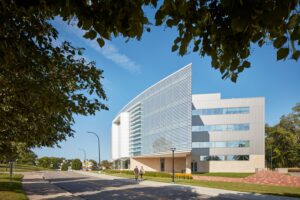
- Kim Kisner
- Community
- 08/15/2023
EPA-Funded Effort Complements SE Michigan GREEN Initiative

The Detroit-Warren-Dearborn Metropolitan Statistical Area (MSA) recently was allocated $1 million to develop a plan for reducing greenhouse gas emissions and other harmful air pollution through the US-EPA’s Climate Pollution Reduction Grants (CPRG) program. The plan will cover the MSA’s six counties – Wayne, Oakland, Macomb, St. Clair, Livingston, and Lapeer – as well as Washtenaw and Monroe counties.
The Southeast Michigan Council of Governments (SEMCOG), which is the lead agency for Southeast Michigan’s Climate Action Plan, will manage the funds. The plan is in place to help local governments improve and maintain Southeast Michigan’s transportation systems, environmental quality, economic interests, and infrastructure.
SBN interviewed SEMCOG Planning Director Kevin Vettraino about what this will involve, how it will roll out, and how it impacts businesses, residents, and communities in Southeast Michigan.
Q: Tell us about SEMCOG.
A: SEMCOG is the regional planning organization for the seven counties that make up the Southeast Michigan region: Livingston, Macomb, Monroe, Oakland, St. Clair, Washtenaw, and Wayne counties.
Our primary mission is to support our local government members, including counties, cities, villages, townships, and educational institutions. We work to improve the quality of the region’s water, make the transportation system safer and more efficient, revitalize communities, and spur economic development. These things shape the areas we get involved in.
I like to say we focus on planning for the issues or opportunities that cross geographic or community boundaries, such as roads, rivers, lakes, air, and the economy.
Q: The U.S. Environmental Protection Agency allocated $1 million to develop plans for reducing greenhouse gas emissions, and SEMCOG is acting as the lead agency to develop a climate action plan. What will this entail?
A: At a high level, the plan will establish community-developed and evidence-based methods to reduce greenhouse gas emissions that will meet the requirements of the EPA and CPRG. One approach is to enhance natural areas that capture carbon. The plan will also integrate extensive stakeholder outreach and input, along with equity considerations, and consider the impact of policies, strategies, and actions from the regional level down to the household level.
This work complements the recently adopted Southeast Michigan GREEN: Strategic Framework for Growing our Resilience, Equity, and Economy with Nature, which is an initiative to address some of the region’s most pressing challenges – managing floods, fostering climate resilience, improving community health, and protecting our natural assets – all while creating vibrant places where people want to live and where businesses will thrive.
Q: What is the next step and timeframe for action?
A: The next step will be launching a task force with the intent to meet at least eight times over two years. Part of the large overarching task force will be smaller focus groups that will cover more specific parts of the plan.
The focus groups have not been formed yet, but they are likely to focus on transit, energy efficiencies, EVs and the impacts of the transition, materials management, and nature-based opportunities and impacts.
Beyond the focus groups is community engagement. This is critical for success. It’s important for us to have a two-pronged approach here, that being education and data sharing and also public engagement and input.
Q: What does community engagement entail?
A: Surveys, local meetings, webinars, and other outreach with a lens toward ensuring that the benefits and policies that come out of this work support all residents, including lower-income residents. These people have traditionally been underrepresented and more impacted, and we need to ensure that any actions we take support them and don’t further negatively impact them.
Q: How will this impact Southeast Michigan businesses and communities?
A: My hope is that through our work there is an education component. In basic terms, we need to make sure we are speaking the same language. There are a lot of terms around climate action such as equity, green infrastructure, etc., and we need to ensure that whether you are a business, community, government entity, or a resident, we all have a similar understanding regarding what these terms mean and why they are important.
I hope that business leaders can see themselves within the strategies, policies, and actions that come out of this work and align with them.
We all have a role to play in this. This plan will not be the silver bullet that can solve the climate challenges in the region but all of us together can make an impact. From installing a green roof or rain garden to ensuring all people have safe facilities to walk or bike to destinations, whether it’s a sidewalk or bike path or considering nature-based and green infrastructure solutions when putting in a new parking lot or reconstructing a roadway, there are things we all need to be thinking about and doing.
Q: What are your main challenges?
A: Again, it’s getting a common set of words and a familiar language.
It’s also about education and making everyone understand the importance of the plan, and working toward a healthier region, and putting sustainability practices in place to support our climate long into the future.
A lot of our work targets dates far into the future, such as 2050, and sometimes it’s difficult to get buy-in when it’s so long-term. The challenge is we need buy-in and immediate action to get to where we want on the horizon.
Q: What are the main opportunities?
A: First, we have the $1 million funding to help develop a plan, inventory our greenhouse gas emissions, and develop policies – which is great.
Through the development of this plan, the region and our communities and businesses will become competitive for an estimated $4.6 billion in EPA grant funding for implementation.
Second, if we are able to get folks both in leadership and residents across the region to both understand the importance of the action plan and to be intentional about environmental justice and the allocation of funds and the action to support those directly impacted, that is a great success.
Q: What advice do you have for Southeast Michigan businesses to get involved?
A: First, sign up to receive information here.
Second, become familiar with the new policies and actions we will be putting in place and see where you may be aligned or be able to support.
If you are a business, ask yourself if there are ways you may be able to provide additional options for employees to transport to work. Making small investments in sidewalks and bike infrastructure, like lockers or parking, and seeing if there are opportunities for EV charging can have an impact. At the same time, offer small incentives related to supporting ride-sharing or looking to reduce impervious pavement with a rain garden or planting trees… The more we can all do our part the better.
Be sure to subscribe to our newsletter for regular updates on sustainable business practices in and around Detroit.
Kim Kisner
- All
- Business
- Community
- Education
- Events

The Chip Bag Project, based in Detroit, is a sustainability initiative that upcycles hard-to-recycle snack packaging — particularly chip bags — into insulated sleeping bags for individuals experiencing homelessness. Founded by Eradajere Oleita, the project addresses both environmental waste and housing insecurity by transforming materials like Mylar into practical, thermally efficient solutions. In June, Oleita was among Trelllis’s 30 Under 30, its annual recognition of the brightest young...

PowerPanel, headquartered in Oxford, focuses on sustainable energy technology with a particular emphasis on hot water systems and thermal energy capture. The company designs and manufactures modular solar hybrid systems that integrate both photovoltaic and thermal components into a single unit. Its goal is to offer energy solutions that are more efficient, durable, and economically viable for a range of commercial and industrial applications. SBN Detroit interviewed Garth...

The Detroit VA Healthcare System is implementing a systemwide sustainability strategy through its Green Environmental Management System (GEMS), designed to reduce waste, lower energy consumption, and improve operational efficiency. The program recently earned Practice Greenhealth’s “Top 25 Environmental Excellence Award.” Through coordinated efforts across departments and a commitment to innovation—particularly in high-resource areas like dialysis—the Detroit VA works to demonstrate how environmental stewardship and clinical care can go...







